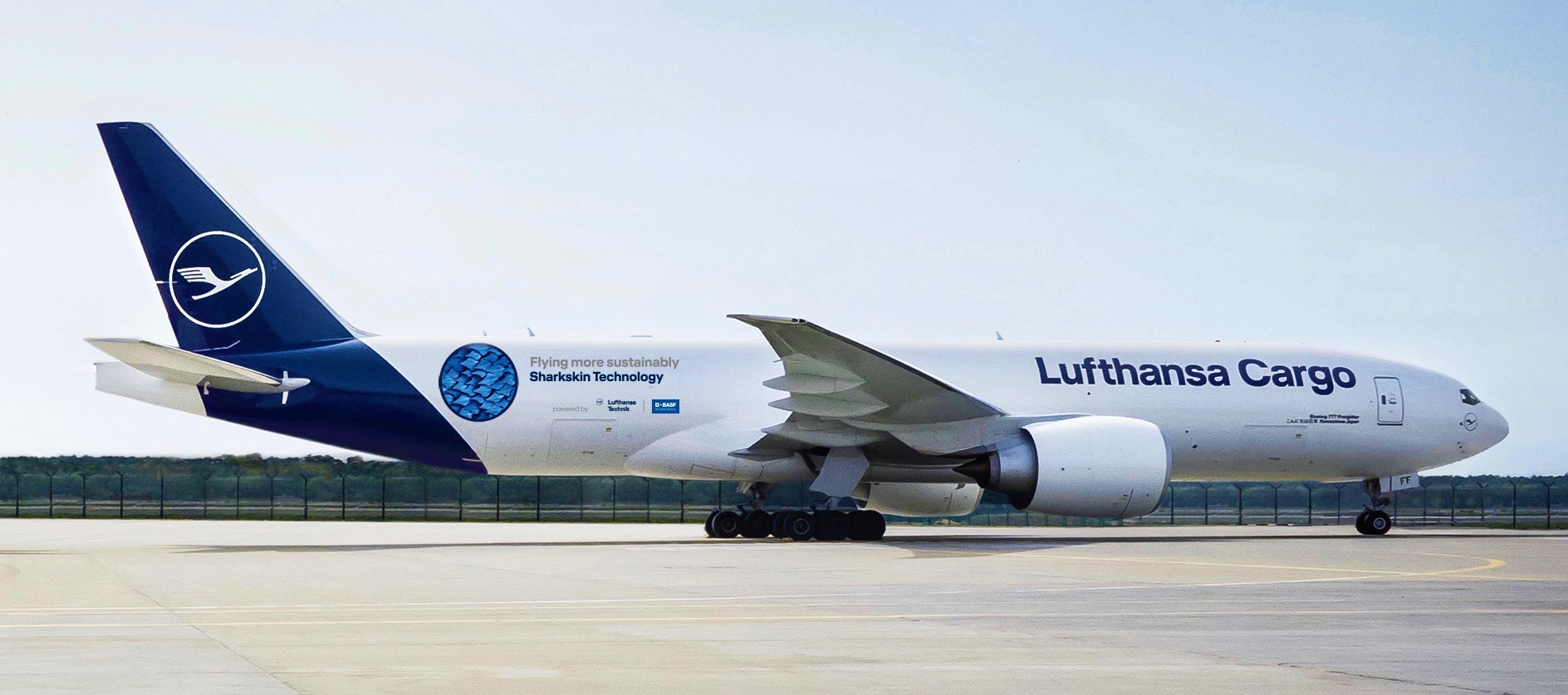


Sharkskin Technology is not new to the aviation industry, for the first time at the end of 2019, Lufthansa Technik and BASF fitted almost the entire lower half of a Lufthansa Boeing 747-400's (D-ABTK) fuselage with 500 square meters of such a jointly developed sharkskin surface and had this modification certified by EASA.

Sharkskin surface modification on Lufthansa B747-400 aircraft.
To the Surprise, it paid off ! During more than 1,500 flight hours of that B747-400, emissions were reduced by around 0.8% apart from fuel savings.
The savings for the Boeing 777F are estimated to be even higher, because the Sharkskin application areas are even larger in this case due to the absence of window rows on a freighter, among other reasons.
The savings are validated using a software for fuel consumption analyses developed by Lufthansa Technik, which allows the effectiveness of a wide variety of different aircraft modifications to be demonstrated reliably based on comprehensive data.
The lower the frictional resistance of an aircraft in the air, the lower the fuel consumption. Using nature as a role model, the aviation industry has been intensively researching ways to reduce aerodynamic drag for many years.
Now Lufthansa Technik and BASF have succeeded in making the breakthrough as part of a joint project. AeroSHARK, a surface film that mimics the fine structure of a shark’s skin, is to be rolled out on Lufthansa Cargo’s entire freighter fleet from the beginning of 2022, making the aircraft more economical and reducing emissions.
The surface structure consisting of riblets measuring around 50 micrometers imitates the properties of sharkskin and therefore optimizes the aerodynamics on flow-related parts of the aircraft.

The Sharkskin Coating (film).
This means that less fuel is needed overall. For Lufthansa Cargo’s Boeing 777F freighters, Lufthansa Technik estimates a drag reduction of more than one percent.
For the entire fleet of ten aircraft, this translates to annual savings of around 3,700 tons of ATF and just under 11,700 tons of CO2 emissions, which is the equivalent of 48 individual freight flights from Frankfurt to Shanghai.
Exterior surfaces used in aviation are exposed to factors such as strong UV radiation as well as temperature and pressure fluctuations at high altitudes, among others. BASF has therefore focused its development on achieving extreme durability and weather resistance.
The key criteria for use in aviation operation include simple application and handling as well as ease-of-repair, for which a custom concept has been developed.
“Responsibility for the environment and society is a key strategic topic for us,” says Christina Foerster, Member of the Executive Board of Deutsche Lufthansa AG with responsibility for sustainability. “We have always played a leading role in introducing environmentally friendly technologies. The new sharkskin technology for aircraft shows what strong and highly innovative partners can achieve collectively for the environment. This will help us to achieve our goal of climate neutrality by 2050.”
“The aviation industry is facing similar challenges to the chemical industry: ongoing progress must be made with climate protection despite high energy requirements. By collaborating closely and successfully combining our know-how in surface design and aerodynamics, we have now succeeded in taking a major step forward. This is an excellent example of sustainability in practice, achieved through partnership-based collaboration and innovative technologies,” says Dr. Markus Kamieth, Member of the Board of Executive Directors of BASF.

“We are proud that we will now be able to operate our entire freighter fleet even more efficiently in the future thanks to sharkskin technology and reduce the carbon footprint of our modern fleet further. The investments we have made in rolling out AeroSHARK at Lufthansa Cargo consciously reaffirm our commitment to the United Nation’s sustainable development goal on climate action,” explains Dorothea von Boxberg, Chief Executive Officer of Lufthansa Cargo AG.
In its cooperation with BASF, Lufthansa Technik is responsible for the material specification, approval by the aviation authorities and performance of aircraft modifications carried out as part of regular maintenance layovers.
Backed by decades of experience as an approved aviation design organization, the company will obtain a Supplemental Type Certificate (STC) for the 777F from the European Union Aviation Safety Agency (EASA), which is required for operation.
“We have always used our wealth of expertise as a global market leader in technical aircraft services to also contribute to reducing the ecological footprint of our industry. In doing so, we can leverage significant savings potential from all aircraft generations,” explains Dr. Johannes Bussmann, Chief Executive Officer of Lufthansa Technik AG. “I am therefore very proud that we will soon be able to transfer the positive findings of the validation phase into the series application with Lufthansa Cargo. The extremely constructive collaboration with BASF is also the best example of cross-sector cooperation in the interest of the sustainability of the aviation industry.”
Pictures : Lufthansa Cargo , and
Sonja Brüggemann, Lufthansa Technik AG
